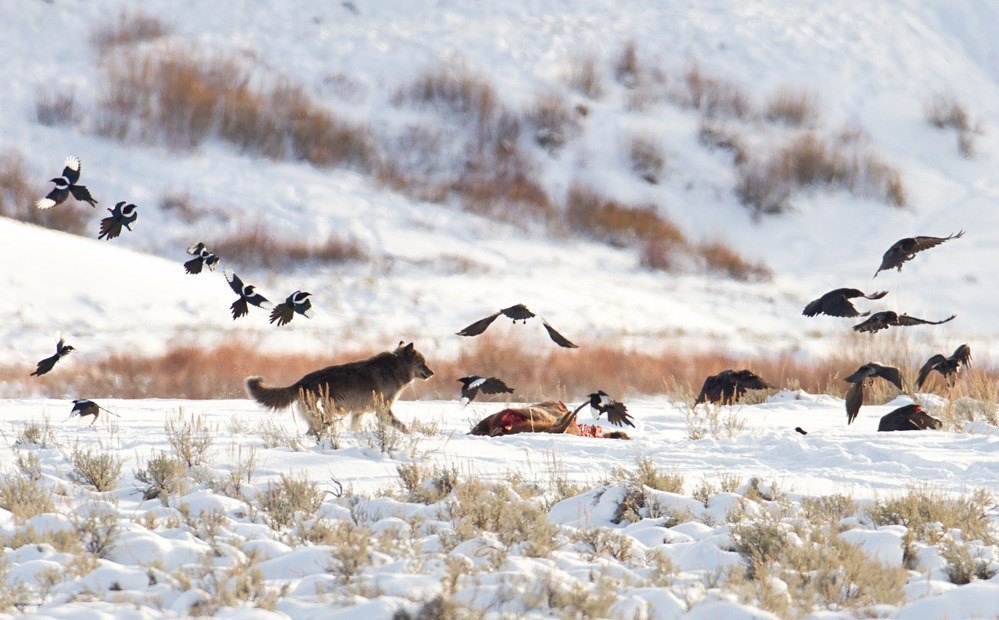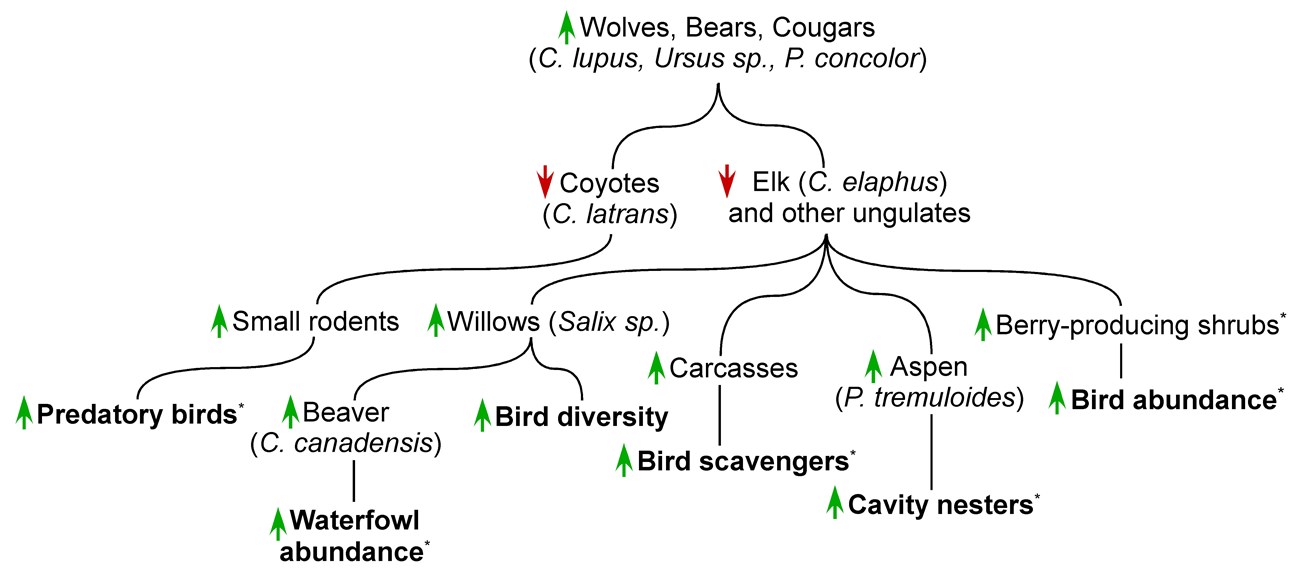Part of a series of articles titled Yellowstone Science - Volume 27 Issue 1: Vital Signs - Monitoring Yellowstone's Ecosystem Health.
Article
SHORT: Yellowstone Birds Are Vital

SHORT: Yellowstone’s Birds Are Vital
by Robert H. Diehl & Douglas W. Smith
Traveling through Yellowstone National Park (YNP), visitors frequently stop to enjoy the park’s birds: small songbirds flitting about the willows, sandhill cranes engaged in their ritual mating dances, or myriad species of waterfowl loafing in one of the park's many wetlands. Typically while driving the roads of YNP, a majority of visitors consider a stopped car and raised binoculars a sure sign of some large mammal sighting. Bird watchers in YNP are familiar with this expectation and steel themselves to deliver the tough news. Certainly the park boasts its share of large charismatic birds, including trumpeter swans and bald and golden eagles; however, next to the bison, wolves, bears, and elk that bring so many visitors to Yellowstone, the park’s birds often seem overlooked.
Regardless, YNP is home to considerable bird diversity. Over 300 species have been documented in the park (McEneaney 2006), and each brings unique habits and behaviors that contribute tangibly to the park’s character and function as a healthy ecosystem.
YNP, like most large geographic areas that vary considerably in elevation, encompasses a variety of habitat types that sustains many bird species, but not all habitats support similar levels of avian diversity. Although spruce-fir forests, certain river corridors, and scattered wetland areas represent a small proportion of the total park area, they often contain rich plant communities that disproportionately concentrate bird life. With a shrinking winter snowpack (“The Spatial Footprint and Frequency of Historic Snow Droughts in Yellowstone,” this issue) and higher-frequency fire regime (“Nowcasting and Forecasting Fire Severity in Yellowstone,” this issue) becoming characteristic of a future Yellowstone that is warmer and drier, spruce-fir forest regeneration may be compromised (Stephens et al. 2013) and wetlands will dry or become more ephemeral (Schook and Cooper 2014) resulting in shifting bird communities and a likely reduction of avian diversity. Park scientists and resource managers are challenged to identify ecological measures, or vital signs, best suited to indicate current and future health of these and other habitats within the park. The most useful vital signs are easy to measure, influence large portions of the ecosystem, and may be biological or non-biological in nature (YCR 2018).
In certain circumstances, bird behavior or population status may play the role of a vital sign by indicating subtle yet important changes in habitat quality that might otherwise defy easy measurement and detection. Unlike most other park fauna, birds cover a lot of ground, making them efficient at tracking environmental change (Tingley et al. 2009) and, therefore, responding by occupying habitats that best suit their needs for food, cover, and nesting locations. In this way the presence or absence of certain birds may serve as a vital sign on the health of local habitats. For example, birds that seasonally move to higher altitudes to breed, so-called altitudinal migrants, tend to be flexible in the timing of their movements and the habitats they occupy (Boyle 2017). Tracking these changes in the timing of migration and the locations of breeding and wintering areas of certain birds may serve as an early and tangible signal of habitat change that may take longer to become apparent by other means.
Rather than serve as vital signs themselves, bird populations more often are the beneficiaries of other more fundamental vital signs such as water quality or the status of some more influential species further up the food chain. Ideal vital signs for birds directly or indirectly indicate the health of bird populations through their influence on key aspects of their biology (e.g., reproduction or foraging). For example, chemical screening of soil, water, or biological samples can detect a variety of potential pollutants or toxins before they reach critical levels that may be harmful to populations. Mercury concentrations discovered in fish samples taken from several lakes within the park exceeded toxicity levels that might be harmful to fish-eating birds (Smith et al. 2016). Alternatively, the status of populations of certain so-called keystone species can serve as a vital sign for the overall health of ecosystems. As their namesake implies, keystone species, often top predators, have disproportionate influence over the character of their ecosystems. Their control of large mammalian prey populations cascades down through the food chain to influence the populations of innumerable species of plants, small mammals, and birds. For example, wolves acting through their influence on ungulates and other prey may indirectly impact the populations of numerous bird species (figure 1).

YNP’s birds, through their diversity and rich repertoire of behaviors, perform numerous ecosystem functions throughout the park. Woodpeckers excavate cavities used by other birds and mammals; nutcrackers and other seed-eating birds promote plant reproduction by dispersing seeds; scavenging birds including vultures, ravens, and eagles consume carrion; and large numbers of insect-eating swallows, flycatchers, warblers, and thrushes spend their breeding seasons converting mosquitos into baby birds. YNP staff conduct numerous surveys each year to monitor park birds. When birds represent essential vital signs, such monitoring helps ensure the health of other plant and animal populations and the unique roles they fill in many habitats.
Literature Cited
Boyle, W.A. 2017. Altitudinal bird migration in North America. The Auk: Ornithological Advances 134:443-465.
McEneaney, T. 2007. Yellowstone bird report 2006. YCR-2007-01. National Park Service. Yellowstone Center for Resources, Yellowstone National Park, Mammoth, Wyoming, USA.
Ripple, W.J. and R.L. Beschta. 2012. Trophic cascades in Yellowstone: the first 15 years after wolf reintroduction. Biological Conservation 145:205-213.
Schook, D.M., and J.D. Cooper. 2014. Climatic and hydrologic processes leading to wetland losses in Yellowstone National Park, USA. Journal of Hydrology 510: 340-352.
Smith, D.W., B.J. Cassidy, D.B. Haines, C.L. Revekant, and K. Duffy. 2017. Yellowstone Bird Program 2016 annual report. YCR–2017–03. National Park Service. Yellowstone Center for Resources, Yellowstone National Park, Mammoth, Wyoming, USA.
Stephens, S.L., J.K. Agee, P.Z. Fulé, M.P. North, W.H. Romme, T.W. Swetnam, and M.G. Turner. 2013. Managing forests and fire in changing climates. Science 342:41-42.
Tingley, M.W., W.B. Monahan, S.R. Beissinger, and C. Moritz. 2009. Birds track their Grinnellian niche through a century of climate change. Proceedings of the National Academy of Sciences 106:19637-19643.
Yellowstone Center for Resources (YCR). 2018. The state of Yellowstone vital signs and select park resources, 2017. YCR–2018–01. Yellowstone Center for Resources, Yellowstone National Park, Mammoth, Wyoming, USA.
Robb Diehl is a Research Ecologist with the U.S. Geological Survey, Northern Rocky Mountain Science Center in Bozeman, Montana. Before joining the USGS, he was an assistant professor at the University of Southern Mississippi. His research focuses on the ecology, behavior, and conservation of migratory birds and advancing remote sensing methods used to study birds and other wildlife.
Last updated: September 18, 2019
